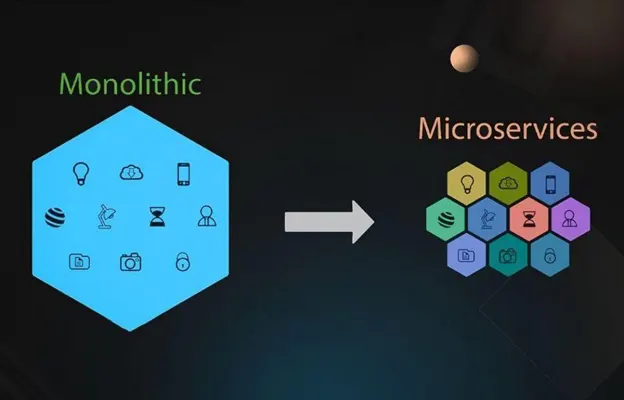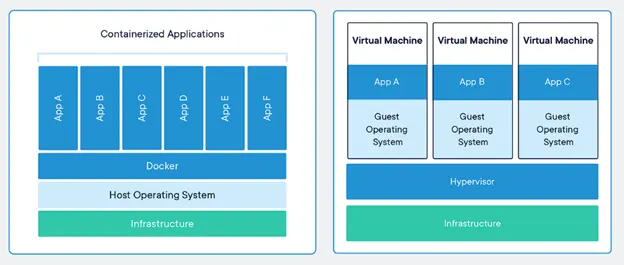Microservices architecture offers compelling benefits like scalability and velocity but how do we build production-ready Node.js services?
This step-by-step guide explores strategies for decomposing monoliths, implementing decoupled communication, containerization, auto-scaling, and monitoring to create truly scalable microservices with Node.js. Follow along to evolve your architecture for sustainable growth!
Monolithic Node.js applications can become unwieldy as codebases grow. Yet many developers struggle to adopt microservices – how do we break apart monoliths into independent services? How do we coordinate them? And what does production-level microservices architecture look like?
This hands-on tutorial will walk through the key steps of building scalable, production-grade microservices using Node.js. We’ll cover decomposing monoliths, applying loose coupling principles, leveraging containers and orchestrators, scaling, and monitoring.
Let’s get started!
Step 1 – Break Monolith into Separate Microservices

The first critical step in migrating to microservices is strategically identifying boundaries to decompose the monolithic Nodejs application development into focused, independent services.
Each service should handle a specific functional domain and own its corresponding data models. Here are effective techniques:
First, analyze the end-to-end architecture of the existing monolith, looking for distinct functional areas and data models that can be extracted into separate microservices.
For example, you may identify user management capabilities like authentication, authorization, profiles, and settings as an ideal domain to break out into a standalone user management service with its dedicated user models.
Additionally, identify related features and workflows that tend to change at roughly the same pace due to correlated requirements or dependencies. These are good candidates for grouping into common services.
At the same time, separate functionalities need to evolve independently into their services. The goal is to maximize cohesion within services while minimizing coupling across service boundaries.
Establish each microservice’s responsibilities, scope, inputs, and outputs to avoid unclear overlap across multiple services.
Services should solve one specific problem space rather than focusing on various issues. Think of services as team units aligning to business capabilities.
Watch for functionality in the monolith that seems to span multiple domains or areas of concern.
These capabilities that don’t cleanly fit into a single service may require careful coordination across multiple microservices rather than strictly living within one.
In general, target around 4-10 services – error on the side of slightly larger but more manageable services versus having too many tiny microservices.
Thoughtfully decomposing the monolith upfront establishes a solid foundation.
Well-scoped microservice boundaries enable the services to evolve independently going forward and maximize team velocity as fewer dependencies slow coordination.
Step 2 – Develop Microservices with Loose Coupling in Mind
Once the monolithic application is broken down into independent microservices in separate codebases, the next priority is implementing an architecture that prevents tight coupling between services. Here are some guiding principles:
First, employ interface-based programming – make services expose abstract interfaces that conceal implementation details rather than concrete classes or architectures.
This reduces versioning headaches and hidden dependencies between services as implementations change.
Leverage asynchronous events, event streams, and lightweight messaging for inter-service communication rather than synchronous request-reply protocols or direct API calls. Event-driven communication decouples the services in time and space.
Avoid ambient dependencies between services – like relying on implicit shared database access or global in-memory state across instances.
Make all dependencies explicit through well-defined interfaces, configurations, and orthogonal communication protocols. This isolates services.
Prefer small, narrowly focused interfaces that provide targeted capabilities rather than large “do everything” interfaces that encourage overuse. Clear interface boundaries prevent uncontrolled expansion of service capabilities.
Hide internal implementation details like frameworks, programming languages, data schemas, etc. from consumer services by keeping public interfaces stable. Don’t leak unimportant internals.
Developing microservices guided by loose coupling principles allows them to remain speedy, flexible, and resilient as both applications and teams grow over time.
Step 3 – Containerize Microservices Using Docker

Once we have well-scoped microservices defined, containers like Docker provide a means to package services in a portable way for reliable deployment across environments:
First, bundle microservices and their dependencies like frameworks, runtimes, libraries, and configurations into Docker container images to encapsulate everything required. This creates immutable containers that run predictably.
For each service, create a Dockerfile that defines its complete runtime environment including aspects like the OS base image, installed dependencies, exposed ports, mounted volumes, environment variables, and more.
The Dockerfile instructs Docker how to build container images for the service deterministically.
These container images are then stored in container registries like DockerHub and tagged with version numbers to manage releases of services over their lifetime. Containers provide versioned, portable environments.
This containerization approach enables replicating and deploying services across different environments like development, testing, and staging consistently without surprises from unseen dependency conflicts or missing configurations that plague custom manual deployments.
Overall, packaging microservices using containers end the headaches of “works on my machine” by encapsulating dependencies and environments immutably.
This portability is essential for reliable microservices architectures.
Step 4 – Orchestrate Containers Using Kubernetes
Once microservices are containerized, the next need is automated orchestration to deploy and connect containers – this is where Kubernetes shines:
First, Kubernetes dynamically schedules and deploys microservices packaged as containers across clustered infrastructure like virtual machines, cloud instances, on-prem servers, etc. This provides portability.
Kubernetes keeps track of where container instances are running and handles routing requests across them intelligently. It also handles container networking, secrets, config distribution, service discovery, updates, scaling, etc.
We provide declarative configs in Kubernetes manifests like Deployments that define the desired state of our microservices – aspects like number of instances, resource quotas, scaling policies, health checks, etc. Kubernetes then reconciles reality to match the desired state.
Additional Kubernetes objects like Services, Ingresses, and LoadBalancers define networking configurations for how to access containers from outside the cluster and connect them internally. This wiring is handled automatically based on declarative specs.
This automated container infrastructure removes enormous operational headaches so developers can focus on just building and improving the microservices themselves rather than managing complex hosting environments.
Overall, Kubernetes provides a self-healing substrate supporting robust microservices architectures through automated container deployment, networking, scaling, and management.
Step 5 – Refactor Code for Scalability
Once microservices are defined, we need to ensure the code inside them is optimized for scalability. Here are patterns to follow:
First, distribute load across service instances by having client requests target a load balancer rather than individual containers.
The load balancer efficiently routes each request to available instances based on load, health, geography, etc allowing services to smoothly scale horizontally.
Implement caching and throttling mechanisms where appropriate to optimize the performance of repeated operations or protect endpoints prone to sudden spikes. This avoids instance overload and optimizes infrastructure usage.
Optimize performance of slow or expensive operations like complex database queries or computations through indexing, batching, parallel execution, etc to make the most efficient use of cloud resources. Don’t block threads unnecessarily.
Choose backing data stores and messaging systems designed for horizontal scalability like Cassandra, Kafka, etc. so capacity can increase seamlessly with additional nodes. Avoid single points of failure.
For stateless processes, horizontally scale out CPU or IO-intensive work across instances using load balancing rather than vertically scaling up single instances which has limits. Distribute work.
Refactoring code with scalability principles prepares microservices for sustained long-term growth. Scalability unlocks true microservices potential.
Step 6 – Implement Service Discovery and Monitoring
Running microservices in production requires mature service discovery and monitoring capabilities:
First, set up a service registry and directory like Consul that serves as a database of active services.
Clients look up current locations here for dynamic routing rather than coding endpoints.
Often, implementing a gateway API pattern with a reverse proxy that owns the external APIs while handling cross-cutting concerns like security, routing, rate limiting, etc. This removes duplication across services.
Instrument services for observability with structured logs, metrics, distributed tracing, etc.
Monitor key health indicators like memory usage, latency, saturation, and errors to surface problems immediately.
Set up alerts to promptly notify teams when any reliability or scaling issues occur or if service level objectives are breached. Rapid detection is key.
Use tools like Grafana to visualize metrics, traces, logs, and dependencies between services in aggregated dashboards for an end-to-end understanding of ecosystem health.
With comprehensive service discovery and monitoring, the health and performance of complex microservices architectures become transparent rather than opaque. This helps address issues and optimize.
Step 7 – Implement Resiliency Patterns
In distributed microservices architectures, dependencies between services can fail unexpectedly for many reasons – networks are disrupted, instances crash, or load spikes cause cascading failures. That requires planning for resilience:
First, implement intelligent retry logic with exponential backoff when making requests to other microservices.
This provides tolerance for many common transient errors or brief network blips. Retrying temporary errors allows applications to self-heal.
Use circuit breakers that trip open when failure rates cross configured thresholds, preventing exhaustive retries that can simply worsen outages and exhaust limited capacity. Circuit breakers allow failures to isolate rather than spread.
Apply throttling or rate limiting if certain downstream service dependencies get overwhelmed by sudden traffic spikes or volumes exceeding scale. This prevents the stampeding herd problem pattern.
When possible, employ graceful degradation so core functionality remains available to end users, just operating in a somewhat limited capacity.
For example, show cached content. Some response, even if diminished, is better than a hard failure.
Return cached data or empty data sets during outages if failures prevent returning real-time responses.
This keeps applications functional rather than failing users outright. Queue requests if they can be fulfilled later after systems are back online.
The goal is to prevent localized service disruptions or spikes from cascading across interconnected microservices and impacting users.
Resiliency patterns limit blast radius when failure inevitably occurs. They maintain continuity.
Step 8 – Secure Communication Between Microservices
With distributed microservices, the expansive internal network surface area requires special security considerations:
First, encrypt inter-service communication channels using mutual TLS, proxies, or similar technologies to prevent eavesdropping on sensitive data exchanged between services across internal networks. Encrypt by default.
Authenticate and authorize all service-to-service requests to definitively confirm the identity of the calling service and allow only appropriate access. Require valid certs.
Use mechanisms like mTLS client certificates, JWT tokens, API keys, etc. to establish trust between services and protect against spoofing of application identities or users to access data.
At the network level, tightly limit service-to-service communication to only explicitly approved flows via allow lists. Block broader inbound network access across services. Reduce attack surface.
Securely distribute, rotate, and manage credentials like certificates, tokens, and connection strings needed for authorized service-to-service interactions. Automate expiration and follow security best practices.
Actively scan container images for vulnerabilities before deployment using tools like Trivy or Dockle. Fix any issues in either app code or OS dependencies.
Applying fundamental security principles like defense in depth and zero trust becomes exponentially more important given the expanded internal access surface of microservices development. Additional controls provide layered protection.
Decomposing monolithic Node.js apps into independent microservices requires careful planning but enables huge long-term productivity and scaling benefits.
How have you evolved architecture as your apps grow? What lessons have you learned about avoiding tight coupling?
We would love to hear about your experiences applying microservices in production!





